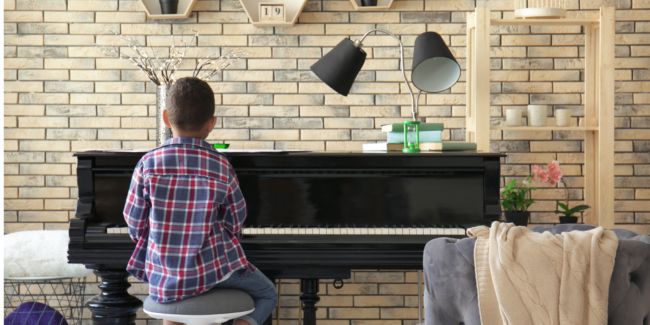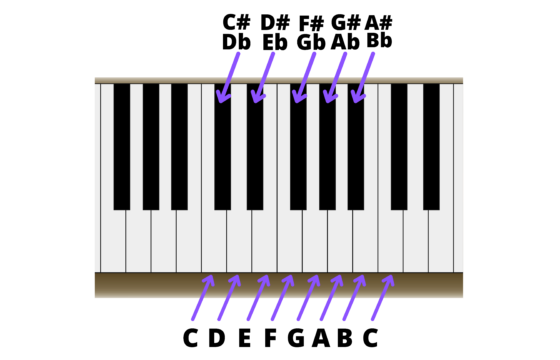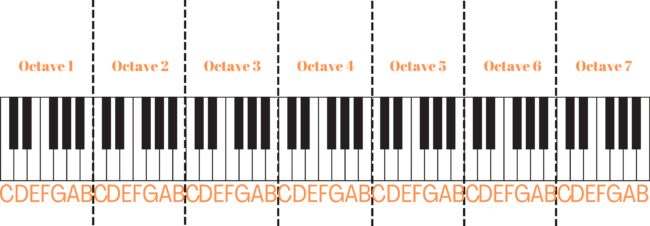How to Play an Octave on Piano

Want to know how to play an octave on piano? Learn all about their structure and function in this guide.
Before we learn to play an instrument, we hear all sorts of musical lingo thrown around. Scales, chords, notes, octaves – what does it all mean?
Acquiring the language of music theory takes time, hard work, and patience. In this article, we’ll give you a head start by diving into the idea of octaves. Specifically, if you’re a beginner at piano, understanding octaves will help you navigate the piano with confidence and freedom.
What is an octave on the piano?
The science of Western music includes twelve frequencies which we call “notes.” We label these notes with the letters A to G, and the symbols sharp (slightly higher than) and flat (slightly lower than).
For more, you can Learn How to Label Piano Keys on our blog.
These twelve notes repeat themselves all the way from the bottom of the piano to the top, across lower and higher frequencies. – pitches.
An octave is the space between the same note at different pitches. The musical term for the spaces between pitches is an interval.
You’re probably wondering: If there are twelve notes between these pitches, why is the space called an octave? What does this have to do with the number eight? This is related to another concept called scales.
Scales.
A scale is a series of notes with a specific pattern of intervals between them. The magic of scales is that you can apply this pattern starting from any note, and it will have the same character.

A scale has seven notes, meaning that when you play the eighth note, it will be the same as the first note, just one octave higher. For example, the C major scale includes the notes C, D, E, F, G, A, and B.
What comes after B? C, again. Hence the term octave.
The standard tuning of Western instruments is determined according to the frequency of note A in the middle of the piano – A is tuned to a frequency of 440hz. The note A, an octave below, is tuned to 220hz; the note A, an octave higher, is tuned to 880hz, and so on. The magic is that when we hear these notes, they all sound like A.
Why are octaves important?
When we first sit at the piano, it looks and sounds like chaos. The idea of an octave is especially confusing. How can it be the same note at a different pitch?
What does that mean?
Once our ears understand the way notes repeat themselves across different octaves, we can make much more sense of the music we hear.
Octaves are so important because are the greatest anchor for creating order when we look at the keys and for training our musical ear. Suddenly the 88 keys of the piano are divided into sections of eight, making the whole thing far more digestible.
How many octaves are on the piano?
The number of keys on a piano has evolved dramatically over time. The piano went from 32 to as many as 96 keys from its birth to modern-day. Most pianos today have seven full octaves, with three extra notes – Bb, B, and C.
The piano is derived from the harpsichord, a seventeenth-century instrument. Harpsichords often had more than one set of keys, but each was around four octaves in length.
The piano’s octave range expanded because musicians demanded it. Composers like Beethoven felt limited in their musical possibilities.
Manufacturers responded by building bigger pianos with iron frames instead of wood, which were stronger and could handle more keys, strings, and octaves.
How to play an octave on piano.
Playing an octave on the piano is easier than you may think. Put the thumb of your right hand on C, for example. Now count to eight, and play the next white key in ascending order with each number. Use whichever fingers feel comfortable for now. When you reach the number eight, you should be back on the note C — one octave higher.

Make sure you don’t skip or add any notes by playing the first and eighth notes simultaneously. If they are a perfect octave, they should resonate powerfully together in a way that will make you say, “yeah, that’s definitely the same note an octave higher.”
Want to take it one step further? Keep repeating this process all the way up and down the keys. With your right foot, press down on the sustain pedal (the right pedal) and then play the note C in all the octaves. The pedal allows the notes to continue resonating even when you’re not holding them down.
Listen deeply and mindfully to this sound to internalize the unique resonance of an octave.
A final tip for practicing octaves.
The best way to learn and practice all musical intervals, including octaves, is by identifying them in songs.
For example, the first two notes of the song ‘Somewhere Over the Rainbow” are a perfect octave. Sing or play the note “some” and then the note “where.”
This is a great way to memorize and identify octaves.
Here is a list of the songs for practicing the other musical intervals:
- Semitone/Minor 2nd: Jaws theme
- Tone/Major 2nd: Happy Birthday
- Major 3rd: Kumbaya
- Minor 3rd: Smoke On the Water
- Perfect 4th: Here Comes the Bride
- Tritone: The Simpsons theme
- Perfect 5th: Twinkle, Twinkle Little Star
- Minor 6th: Lchaim, To Life! (Fiddler on the Roof)
- Major 6th: My Bonnie
- Minor 7th: Star Trek theme
- Major 7th: Don’t Know Why (Norah Jones)
- Octave: Somewhere Over the Rainbow









